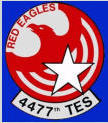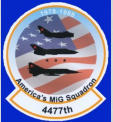


The 4477th Test and Evaluation Squadron (4477th TES) was a squadron in the United
States Air Force under the clemency of the Tactical Air Command (TAC). It is currently inactive.
The product of Project Constant Peg, the unit was created to train USAF pilots and weapon
systems officers, and USN and USMC Naval Aviators and Naval Flight Officers to better fight the
aircraft of the Soviet Union. Some 69 pilots, nicknamed Bandits, served in the squadron
between 1979 and 1988, flying MiG-17s, MiG-21s and MiG-23s.
Air Force Declassifies Elite Aggressor Program
(American Forces Press Service)
WASHINGTON, Nov. 13, 2006 – After decades of secrecy,the Air Force today acknow-
ledged that it flew Communist-built fighters at the Tonopah Test Range north-west of Las Vegas,
from 1977 through 1988, the program, known as Constant Peg, saw U.S. Air Force, Navy, and
Marine aircrews flying against Soviet-designed MiG fighters as part of a training program where
American pilots could better learn how to defeat or evade the communist bloc's fighters of the
day.
Brig. Gen. Hawk Carlisle [1], commander of the 3rd Wing at Elmendorf Air Force Base,
Alaska, is a former member of the 4477th Test and Evaluation Squadron who remembers the
valuable training the unit provided.
"Constant Peg afforded pilots an opportunity to learn how to fight enemy aircraft in a
controlled, safe environment, without having to endure the risks of actual air combat," Carlisle
said. "Typically a pilot would start with a basic familiarization flight to observe the enemy airplane
and study its characteristics, practising one-on-one defensive and offensive maneuvers against
it, and finally, experience multi-bogey engagements high over the desert scrubland of the Nellis
Air Force Base ranges.”
As a result of marginal performance of American fighter forces in the skies over North
Vietnam, Constant Peg complemented other revolutionary training programs such as Red Flag,
Top Gun and the Air Force and Navy-Marine aggressor squadrons. The program also was
intended to eliminate the "buck fever" or nervous excitement many pilots experience on their first
few combat missions. Historical experience indicated that pilots who survived their first 10
missions were much more likely to survive a complete combat tour, and Constant Peg was
intended to teach them the right "moves" to enable them to come out on top of any engagement.
The end of Constant Peg nearly coincided with the end of the Cold War, by which time some
of its "graduates" had already proven themselves in actual air combat.
Threat aircraft flown by the Red Eagles spanned several decades and technical generations
of capability. There was the MiG-17 Fresco, a small, agile single-seat transonic fighter placed in
service just after the Korean War and used extensively over Vietnam and the Middle East; the
MiG-21 Fishbed, a high supersonic fighter used worldwide in large numbers; and the swing-wing
MiG-23 Flogger, likewise in global service, an attempt by the Soviets to match the sophisticated
capabilities of the F-4 Phantom.
“Although it came too late to influence Vietnam, Constant Peg training greatly influenced the
success of American airmen in Operation Desert Storm, who shot down 40 Iraqi fighters, many
of which were Fishbeds and Floggers," Carlisle said.
(From a U.S. Air Force news release)
[1] After this article was written Brig. Gen. Hawk Carlisle was promoted to General and was the Commander of Air Combat
Command at Langley Field Joint Base Langley-Eustis, Virginia.























